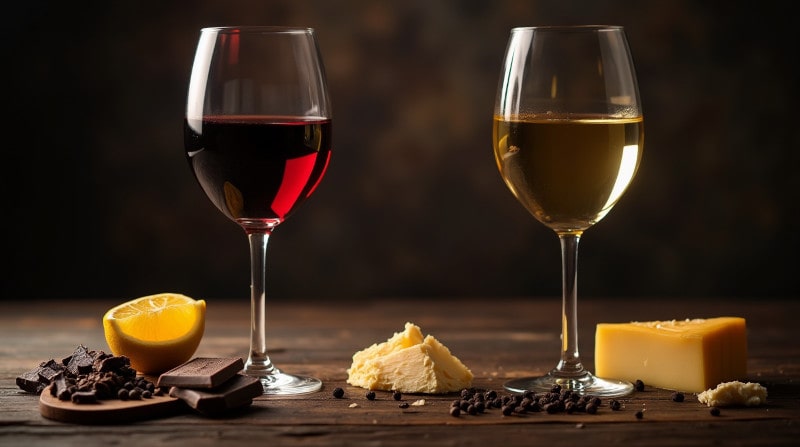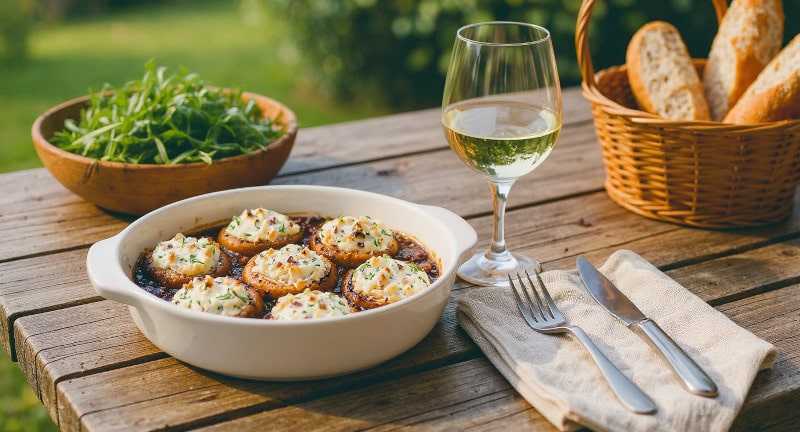How taste & texture influence wine pairing
The choice of the right wine for a dish depends not only on the wine itself – the characteristics of the food also play a decisive role. The ingredients, preparation method, seasoning and texture of a dish determine whether a combination is harmonious or rich in contrast.
The most important influencing factors in food include acidity, sweetness, salt, umami, fat, bitterness and spiciness. Each of these components influences the perception of wine and can either round off or challenge the pairing. In this section, you will learn how these flavor elements affect the pairing with wine and which wine styles go particularly well with which dishes.
1. acidity – freshness & structure in the dish
Acidity gives dishes freshness and clarity. Acidity is a dominant factor in Mediterranean cuisine in particular – for example through tomatoes, lemon juice or vinegar.
Typical acidic ingredients:
- Citrus fruits (lemon, lime)
- Vinegar (balsamic vinegar, wine vinegar)
- Tomatoes
- Pickled vegetables
Influence on pairing:
- Wine must have at least as much acidity as the dish, otherwise it will come across as stale. → Example: Sauvignon Blanc goes perfectly with lemon chicken or ceviche.
- Acidity balances out fatty dishes → A fresh Riesling harmonizes with creamy sauces and fried foods.
- Acidity can emphasize the tannins in red wine → It is therefore better to choose acidic red wines (e.g. Chianti) with tomato sauces.
2. sweetness – balance or challenge for pairing
Sweet foods have a considerable influence on the perception of wine. A dry wine can quickly appear bitter or flat due to sweetness in food.
Typical sweet ingredients:
- Honey & maple syrup
- Fruity chutneys
- Glazed meat dishes
- Desserts
Influence on pairing:
- The wine should be sweeter than the dish, otherwise it will be unpleasantly sour or bitter. → Example: Sauternes goes perfectly with foie gras or dessert.
- Sweetness softens the bitterness of tannins → A strong Amarone harmonizes wonderfully with a sweet, reduced gravy.
- Sweetness in combination with spiciness → Perfect for residual sweet wines such as Riesling Spätlese with Asian dishes.
3. salt – an enhancer for wine aromas
Salt enhances flavors in food and influences how a wine is perceived.
Typical salty dishes:
- Seafood & oysters
- Smoked food (ham, fish)
- Blue cheese
- Salty snacks (potato chips, olives)
Influence on pairing:
- Salt softens the bitterness of tannins → Strong red wines such as Malbec or Syrah therefore go well with grilled, salted meat.
- Salt & acidity complement each other perfectly → A mineral Chablis or Albariño goes wonderfully with oysters or salted fish.
- Salty snacks and sparkling wine are a dream team → Champagne & truffle potato chips or sherry & salted almonds are ideal combinations.
4. umami – the secret flavor carrier
Umami, often described as a “savory” or “spicy” taste, enhances the depth of a dish.
Typical umami-rich dishes:
- Matured cheeses (Parmesan, Gruyère)
- Mushrooms (porcini mushrooms, truffles)
- Soy sauce, miso
- Matured meat & ham
Influence on pairing:
- Umami increases bitterness & tannin → This is why mature, soft red wines (e.g. Pinot Noir, Merlot) work better than tannin-rich wines.
- Umami emphasizes mineral notes in the wine → A Silvaner or Riesling is ideal with mushroom dishes or sushi.
- Matured wines & umami-rich dishes harmonize particularly well → A mature Rioja with mature Manchego cheese is a classic combination.
5. fat – Needs contrast or supplementation
Fat is a flavor carrier, but can dominate the mouthfeel. The right wine provides balance.
Typical high-fat foods:
- Butter & cream sauces
- Fried & deep-fried
- Cheese fondue
- Grilled meat with fat content
Influence on pairing:
- Acidity cuts through fat & refreshes the palate → A crisp Sauvignon Blanc or a dry Riesling is ideal with fatty dishes.
- Tannins combine with fat & appear softer → That’s why Cabernet Sauvignon & steak are a perfect pair.
- Carbon dioxide in wine cleanses the palate → Champagne & fried food are an ingenious combination.
6. bitterness – requires sensitivity
Bitter notes in food can be difficult, as they intensify bitterness in wine.
Typical bitter ingredients:
- Rocket, chicory, artichokes
- Dark chocolate
- Coffee & Espresso
- Radicchio
Influence on pairing:
- Bitter foods intensify tannins → therefore better combined with soft, fruity red wines (e.g. Primitivo, Grenache).
- White wines with fruitiness balance out bitterness → A Pinot Gris or Viognier can harmonize well with chicory.
- Sweetness can balance bitterness → Port wine with dark chocolate is a classic.
7. spiciness – needs cooling & fruitiness
Spicy food requires wines that do not intensify the spiciness.
Typical spicy ingredients:
- Chili & pepper
- Ginger & wasabi
- Hot curry dishes
Influence on pairing:
- Sweetness buffers spiciness → Residually sweet wines such as Riesling or Gewürztraminer go perfectly with Thai or Indian cuisine.
- High alcohol increases spiciness → It is therefore better to choose light, fresh wines than strong red wines.
- Sparkling wines can soften spiciness in a refreshing way → A Prosecco can harmonize well with spicy snacks.
Conclusion: Mastering the balance between food & wine
The different flavor elements of a dish influence how a wine is perceived. Successful wine pairing therefore takes into account not only the wine, but also the characteristics of the food. If you know the interactions between acidity, sweetness, salt, fat, umami, bitterness and spiciness, you can create harmonious or contrasting combinations.
🍷 Experiment with these principles and find your perfect wine pairings!




